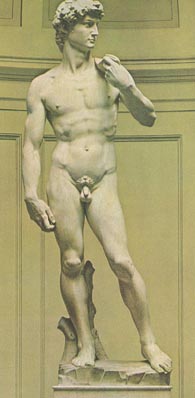Clues of how N made the David

Source:"Michelangelo's Mountain",Eric Schliano, Free Press, New York, 2005, p 99.
|
WlTIH ALL FLORENCE WAITING, Michelangelo had to conceive a figure that
would fit the rough form that Agostino di Duccio or another hand had already
hacked out. Exactly how he did this remains something of a mystery, because
he built a wooden screen around the block in the duomo workshop and, as Vasari
recounts, "worked without anyone seeing it."
But some clues can be drawn from the sculpture's unusual form and the marks on its surface. The block was extremely shallow, with a width-to-depth ratio of about seven to four. This explains why David's upper body leans forward slightly: to fit it in the block, Michelangelo had to position it above the extended left leg and feet; there was no room for the figure to toss his head back. Some modern critics assail this flattening of the figure as a fatal accommodation, conducing to what one calls "a very shallow view of humanity?" But it is a classic instance of necessity begetting invention, and expression: the flattened frame and forward tilt give the David an anticipatory tension, as though he pushes against an invisible barrier, gathering strength before springing through it. The block's limits even define David's distinctive hairstyle, which sweeps forward like a ship's bow to a pointed, bill-like forelock. When the statue is viewed from above, it becomes evident that the head had already been roughed in as a square, facing directly forward and bound by the block's shallow depth. Rather than carve a squat, flat face, Michelangelo turned the head on the diagonal, making maximum use of the limited stone available, with nose, chin, and forelock pointing to one corner. 16 This dictated the odd hairstyle, but it also let Michelangelo achieve the David's iconic long profile. And most impor-tant, it enabled him to inject life into the stiff, frontal form that Agostino di Duccio or whoever had roughed out. From a soldier standing face-front at attention, he formed a coiled, animate young athlete stepping right out of the block. As Vasari said, he did indeed bring the dead to life. |